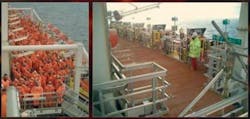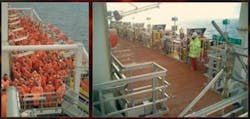The business case for investing in safety
Svein Thorsen
Statoil
Doug Woodbridge
S3 ID Group
The Statfjord field, straddling the Norwegian/UK median line in the North Sea, is one of the largest fields in this sector, at its peak producing over 700,000 b/d of oil. The oil is loaded offshore and taken directly to refineries, while the field’s gas is transported via the Statpipe pipeline to mainland Norway and via the Brent field to the UK mainland.
Statfjord has been developed using three production platforms, Statfjord A, B, and C. Each comprises around 250,000 metric tons (275,578 tons) of concrete with around 40,000 metric tons (44,092 tons) of topside processing modules, and accommodation facilities for over 1,000 personnel.
With such a substantial offshore infrastructure in a harsh environment, and with the safety and welfare of the crew in mind, Statoil decided in 2006 to improve emergency preparedness across the complex. One key focus was on how to register personnel in an evacuation situation and keep their Emergency Preparedness Management Team (EPMT) fully updated about an evacuation status in real-time. Following evaluation of the in-place “paper”-based systems, management realized there was room for improvement by adopting an Electronic Personnel Registration System (PRS).
While musters could be achieved within 20 minutes using conventional techniques, in line with Norwegian legislation, this could prove to be demanding in a crisis. Statoil sought improvements by removing, as far as possible, the human variable and the risk of human error during mustering. In the event of a crisis, Statoil sought to ensure that safety was not compromised through failing to properly account for personnel, so that the search for those missing could take place faster and at the same time prevent the risk of unnecessarily sending rescue teams into a danger zone to find those incorrectly marked as missing. An electronic PRS is not subject to human error under stress, which means the real-time data and counts are reliable.
In a crisis, clear communication is critical and improving speed and accuracy of communication can be a lifesaver. In such situations, the role of the radio operator takes on a new dimension. Radio traffic peaks as the crisis develops and the volume of information needed by the EPMT to coordinate search and rescue activity grows exponentially. The PRS specified by Statoil was designed to reduce the burden on the radio operators, further mitigating the risk of human error by streamlining communication and making information directly available in real-time to the emergency teams across all platforms.
Statoil has a “No injury/zero harm” target. This safety focus underpins the company’s business ethic – it continually strives to create a safe workplace for all personnel, thus avoiding accidents and occupational illnesses. There is also a strong emphasis on high technical standards and inherent safety in the design and operation of all the company’s plants and installations.
Registering personnel in an evacuation situation is vital part of any emergency preparedness scenario, and an electronic personnel registration system can be a key part of any offshore operator’s emergency toolkit.
The PRS satisfied these criteria, but could bring further advantages in business terms. In addition to minimizing the risk of human error and reducing muster times in a real crisis, the PRS would streamline muster drills to reduce the time required to carry out these necessary exercises and to get personnel back to work more rapidly, thereby cutting lost man-hours.
Another benefit was a reduction in time and lost production costs associated with restoring operations following an emergency muster, which requires that all personnel be fully accounted for before production can resume.
Manual “paper”-based mustering techniques can be time consuming both to administer and later to generate post-muster reports. An electronic PRS does this automatically, with a full history being stored and reports generated at the touch of a button.
The Statfjord PRS
Statoil selected S3 ID to supply the PRS. This company provides a range of location awareness systems and manufactures the S3 products, which provide solutions from personnel and asset tracking, personnel on board (POB), mustering, access control, safety, and security to travel logistics management. Other attractions for Statoil were that the products are ATEX certified and use patented technology proven in operations worldwide.
The PRS supplied by S3 ID provides an automated system using individual radio frequency identification (RFID) active transponder tags allocated to all Statfjord personnel to register personnel during a platform muster. The transponder, which is certified “intrinsically safe for use in hazardous areas,” resembles a watch in size and shape, and is worn at all times to ensure that personnel arriving at their designated muster station are detected as they pass through or by the PRS muster station antennas. Currently 3,200 tags are in use.
Under normal operation, personnel are issued with a transponder at the onshore heliport. The PRS logs the transponders’ unique identification code to the individual. When a muster is initiated on a platform, the person is registered by the PRS whenever the transponder is detected at the designated muster station.
The PRS uses three pairs of redundant PC servers that maintain an Oracle database record of all muster activities for each platform. The mustering data is gathered from transponder readers at the muster stations.
A number of PRS operator workstations are located on each platform’s local area network, as well as the onshore heliport, and have access to PRS information screens. An overview screen shows a summary of an active muster and a number of reports can be generated with current or historical data. In the event of an incident, individual muster lists or incident duties will be available via the PRS operator screen and on hardcopy reports.
The heliport onshore has PRS workstation PCs fitted with PRS transponder tag allocators. This enables offshore personnel to be issued a transponder and registered to the PRS on arrival at the heliport. On return to the onshore heliport, the system de-registers each individual and their tag is handed in. A workstation PC and backup tag allocation system is also provided in the Sky Lobby of each installation when required to enable transponder allocation.
The PRS has been operational across Statfjord for over three years and has effectively addressed the risks and reduced human error associated with paper-based manual mustering techniques. The system today is a part of everyday offshore life and is an integral part of the safety preparedness arrangements across the field. The technology provides definitive location awareness of personnel from point of departure to personnel on board. It also ensures personnel can be sure their wellbeing is Statoil’s prime concern with the reassurance that should the worst happen there will be the minimum delay in mustering and getting them to safety.
Recently, Statoil awarded S3 ID a new contract for 24/7 system maintenance and support.
Offshore Articles Archives
View Oil and Gas Articles on PennEnergy.com


